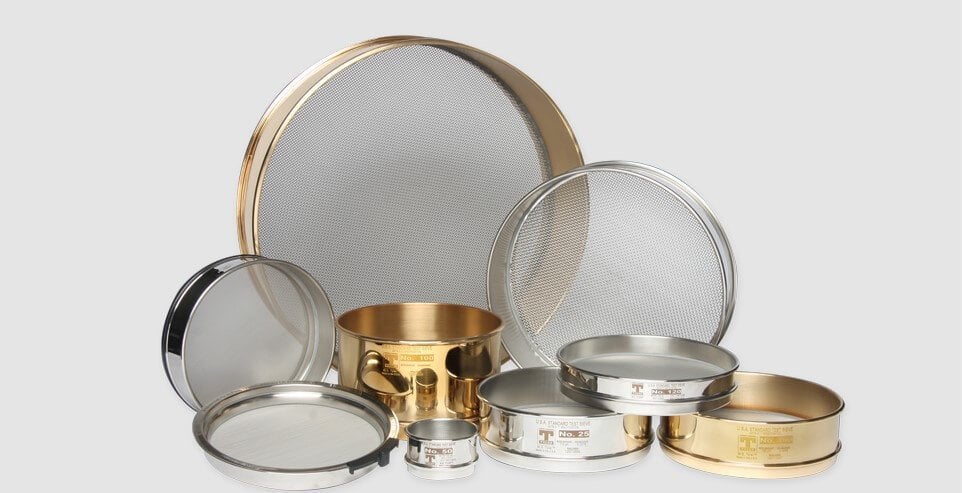What To Expect With a Test Sieve Purchase (Hardware, Setup, and Replacement)
Sieving has been an imperative screening practice for centuries, gaining tremendous popularity during the gold rush. In the world of particle size analysis, test sieves are used to sieve sample material and determine the overall quality of the material that makes up a production line.
But for the most part, test sieves are a dime a dozen, delivering similar functionality to produce the same end result of a dependable particle size distribution curve. That said, what should you expect when a W.S. Tyler sieve arrives at your facility?
W.S. Tyler has been a leading test sieve manufacturer for over 140 years, and we strive to use the experience within our facility to help lab operators best incorporate test sieve analysis equipment to yield desirable results that are accurate and repeatable.
With that, to paint a vivid picture of what to expect when purchasing W.S. Tyler test sieves, this article will cover:
- What a test sieve is
- What you receive when you purchase a test sieve
- What steps you should take when you unbox your test sieve
- What actions you should take in the event that you receive a faulty test sieve
What Is a Test Sieve?
In the world of particle size analysis, test sieves are instruments that house screening media, such as woven wire mesh and perforated plate. This screening media features precise pore openings of uniform shape and size to help screen particles of a specific size.

In most cases, multiple test sieves stacked on top of one another are used during a test sieve analysis. A properly assembled test sieve stack consists of the coarser sieves at the top, progressively getting finer going down the stack.
When a Test Sieve First Arrives What Will I Receive?
When your test sieve order arrives at your facility, you will receive the test sieve(s) you requested and a certificate of compliance. The test sieve will be labeled with its mesh size as well as its serial number.
The certificate of compliance is a document that states that the sieve was manufactured to comply with either ASTM E11 or ISO 3310 standards, the two primary standards for governing test sieves. To that end, the certificate of compliance will also have the serial number of the test sieve it was generated for.
What Should I Do When I First Unbox My Sieve?
It's usually a good idea to record the serial number of your new test sieves in your quality control documents. This is because a new sieve is a new measurement tool, and having this information documented ensures the right sieves are being used.
To that end, you should record the date each sieve is first used as well. This will allow you to keep track of how many times any given sieve has been used so you can do a regular spot check of the mesh and send the sieve in for recertification after a certain period of time.
You can also wash your sieves after unboxing them. That said, this is not a necessary step but may be beneficial depending on what material is being tested.
NOTE: You may notice that wire mesh sieves have a stamp reflecting the mesh specification directly on the mesh. This is just so the manufacturer can keep track of the different mesh sizes and will not hinder your test sieve analysis process.
What Should I Do if My Sieve Is Damaged Upon Arrival?
If your sieve arrives with hindering damage, you should call the distributor you purchased the sieve from. If you buy your test sieves directly from W.S. Tyler, you should reach out with a picture of the sieve.
If you require a replacement sieve, we do as that you send the damaged sieve back to our facility. We will then either issue a replacement sieve or a credit to your account, depending on how you want to handle the situation.
Makes the Most Out of Your Test Sieves With Regular Maintenance
Test sieves are an essential particle size analysis instrument that allows lab operators to utilize test sieve analysis methods to generate a particle size distribution curve. That said, when you order a test sieve, you can expect to revise the sieve speciation you requested as well as documentation that details the qualities of the sieve.
Now, once you have integrated your new sieve(s) into your process, you are going to want to do everything you can to keep your sieve(s) in tip-top shape. The best way to do this in implement some best practices when maintaining them between each use.
Having been a prominent leader in the particle size analysis industry for over 140 years, W.S. Tyler understands that reliable results come from using reliable equipment.
For that reason, we wrote the following article to give you a better understanding of the best practices you should use when maintaining your test sieves:
About Ronnie Brown
Ronnie is the Content Writer for W.S. Tyler and has four years of experience as a professional writer. He strives to expand his knowledge on all things particle analysis and woven wire mesh to leverage his exceptional writing and graphic design skills, creating a one-of-a-kind experience for customers.



